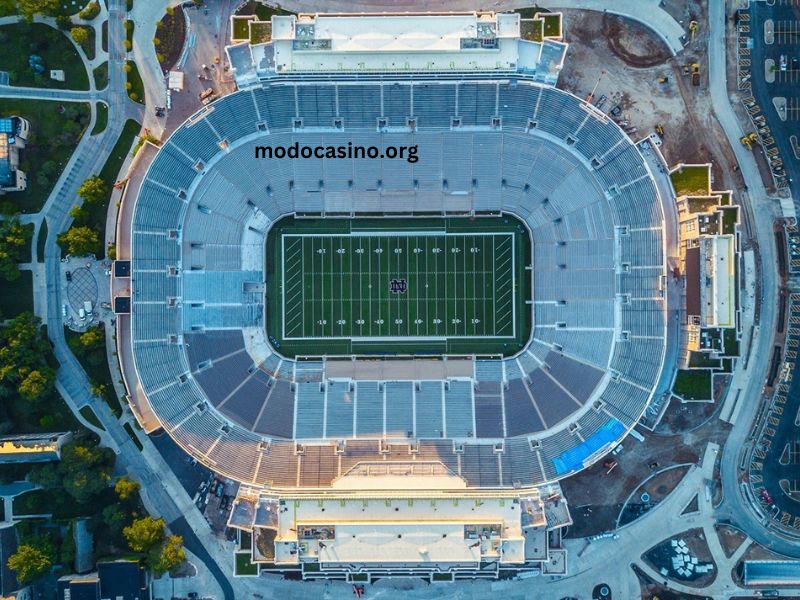1. Michigan Stadium – Ann Arbor, Michigan
Capacity: 107,601
Known as “The Big House,” Michigan Stadium is the largest stadium in the United States and the second-largest in the world. Located in Ann Arbor, Michigan, this iconic venue is home to the University of Michigan Wolverines football team. Since its opening in 1927, the stadium has been a central fixture in college football, renowned for its impressive size and the raucous atmosphere it fosters during game days.
Michigan Stadium’s massive seating capacity makes it a magnet for large crowds, with its record attendance reaching over 115,000 during a 2013 game. Its design reflects a classic bowl shape, allowing for unobstructed views from virtually every seat. The stadium has undergone several renovations to improve facilities and accommodate the ever-growing number of fans. It also hosts events beyond football, including concerts and international soccer matches.
2. Beaver Stadium – University Park, Pennsylvania
Capacity: 106,572
Beaver Stadium, located on the campus of Penn State University, is the second-largest stadium in the U.S. and an integral part of college football culture. Opened in 1960, it is named in honor of the university’s Beaver family and has since become a hallowed ground for Penn State Nittany Lions fans.
The stadium’s impressive capacity and the passionate fan base contribute to one of the most electrifying environments in college sports. The “White Out” games, where fans don white attire in unison, create a sea of white that engulfs the stadium, amplifying the home-field advantage. Beaver Stadium has also been the site of several memorable games and significant moments in college football history.
3. Ohio Stadium – Columbus, Ohio
Capacity: 102,780
Ohio Stadium, affectionately known as “The Horseshoe,” is home to the Ohio State Buckeyes football team. Situated on the campus of Ohio State University in Columbus, this stadium has been a cornerstone of college football since it opened in 1922. The stadium’s distinctive horseshoe shape is a defining feature, providing an intimate yet grand setting for games.
The stadium’s capacity has fluctuated over the years due to renovations and expansions, but it consistently ranks among the largest in the country. Known for its vibrant game-day atmosphere, Ohio Stadium boasts a tradition of the “Script Ohio” performance by the Ohio State Marching Band, which is a fan favorite. The stadium also hosts various events, including concerts and high school football championships.
4. Kyle Field – College Station, Texas
Capacity: 102,733
Kyle Field is the home of the Texas A&M Aggies and is located on the university’s campus in College Station, Texas. Opened in 1904, the stadium has grown significantly in size and importance, with its most recent expansion completed in 2015. The stadium is renowned for its intimidating environment, largely due to the fervent Aggie fan base, which plays a crucial role in making Kyle Field one of the most challenging venues for opposing teams.
The stadium’s design includes an expansive bowl shape that enhances crowd noise and energy. Kyle Field has hosted several notable games and is a central element of Texas A&M’s athletic and social culture. The “12th Man” tradition, where fans stand throughout the game to support their team, is a hallmark of the stadium experience.
5. Darrell K Royal-Texas Memorial Stadium – Austin, Texas
Capacity: 100,119
Located on the campus of the University of Texas at Austin, Darrell K Royal-Texas Memorial Stadium is the home of the Texas Longhorns football team. Opened in 1924, the stadium is named in honor of the former Longhorns coach, Darrell K Royal. It is one of the largest football stadiums in the U.S. and is a focal point for the university’s sports and community activities.
The stadium’s design allows for a massive crowd while maintaining an excellent view from almost every seat. Its capacity has been increased several times, reflecting the growing support for the Longhorns. The stadium is known for its vibrant and enthusiastic fan base, contributing to an intense game-day atmosphere.
6. Tiger Stadium – Baton Rouge, Louisiana
Capacity: 102,321
Tiger Stadium, also known as “Death Valley,” is home to the Louisiana State University Tigers football team. Located in Baton Rouge, Louisiana, the stadium has earned a reputation for being one of the most formidable venues in college football due to its intense crowd noise and enthusiastic fans. Opened in 1924, the stadium has undergone numerous expansions and renovations to maintain its status as a top-tier facility.
The stadium’s design emphasizes the verticality of the seating, which enhances the volume of crowd noise and creates a daunting experience for visiting teams. The tradition of the “Tiger Walk,” where fans line the entrance route for the team, adds to the electrifying atmosphere of game days.
7. FedExField – Landover, Maryland
Capacity: 82,000
FedExField is the home stadium of the Washington Commanders of the National Football League (NFL). Located in Landover, Maryland, this stadium opened in 1997 and was initially known as Jack Kent Cooke Stadium. It is one of the largest NFL stadiums and has hosted numerous significant events beyond football, including concerts and soccer matches.
The stadium’s design includes modern amenities and luxury suites, catering to the diverse needs of its large audience. FedExField has seen various updates over the years to enhance the fan experience, and it continues to be a key venue for major sporting events in the Washington, D.C., metropolitan area.
8. AT&T Stadium – Arlington, Texas
Capacity: 80,000 (expandable to 100,000)
AT&T Stadium, also known as “Jerry World” after Dallas Cowboys owner Jerry Jones, is located in Arlington, Texas. Opened in 2009, it is home to the Dallas Cowboys of the NFL and is renowned for its impressive architectural design and state-of-the-art features. The stadium can accommodate up to 100,000 spectators for major events, making it one of the largest venues in the country.
The stadium’s most striking feature is its retractable roof and massive high-definition video screen, which spans the length of the field. AT&T Stadium is not only a football venue but also hosts various other events, including college football games, concerts, and wrestling matches.
9. Lambeau Field – Green Bay, Wisconsin
Capacity: 81,441
Lambeau Field is the iconic home of the Green Bay Packers and is one of the oldest stadiums in the NFL, opening in 1957. Located in Green Bay, Wisconsin, this stadium is known for its storied history and passionate fan base. The “Froze Tundra,” as it is affectionately called, is renowned for its cold weather games and historic significance in NFL lore.
Lambeau Field’s charm lies in its traditional design and the deep connection it has with the local community. The stadium is a shrine to Packers history, with its Hall of Fame and various tributes to legendary players and moments. The atmosphere at Lambeau Field is unique, blending historical significance with a modern fan experience.
10. Rose Bowl Stadium – Pasadena, California
Capacity: 88,565
The Rose Bowl Stadium, located in Pasadena, California, is one of the most famous sports venues in the U.S. Opened in 1922, it is renowned for hosting the annual Rose Bowl Game, a key fixture in college football’s bowl season. The stadium also hosts various other events, including soccer matches and concerts.
The Rose Bowl’s design reflects its classic architecture, with a distinctive bowl shape and picturesque setting against the backdrop of the San Gabriel Mountains. The stadium has seen numerous renovations to modernize facilities while preserving its historic charm.
Conclusion
The largest stadiums in the United States are more than just venues for sporting events; they are landmarks of cultural and historical significance. Each stadium has its unique features, traditions, and contributions to American sports culture. From the massive capacities of Michigan Stadium and Beaver Stadium to the architectural marvels of AT&T Stadium and the historic Lambeau Field, these venues represent the pinnacle of American sports architecture and fan engagement. Whether hosting thrilling football games, major concerts, or other significant events, these stadiums continue to capture the imagination and enthusiasm of millions across the country.




